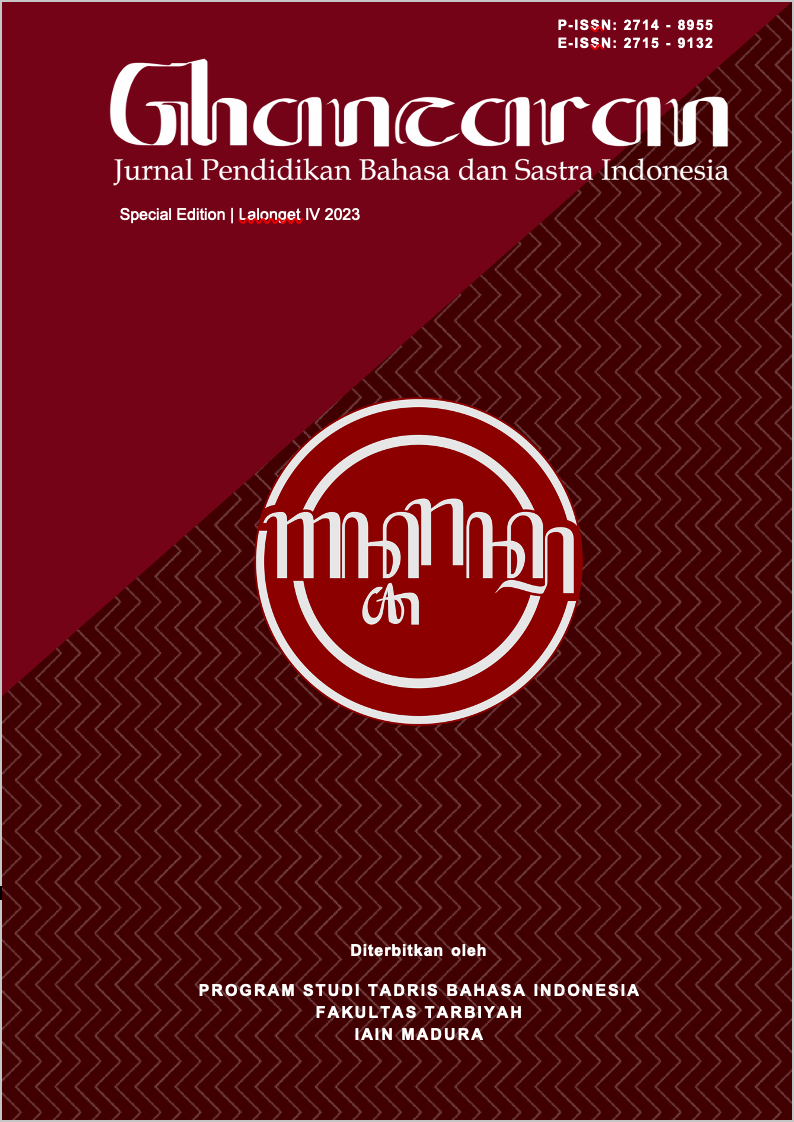Tanggapan Pemelajar Asing Tingkat Mahir dalam Pembelajaran Bahasa Indonesia terhadap Bahan Ajar Berbasis Web dengan Materi Cerita Pendek
 Abstract views: 224
,
Abstract views: 224
,
 PDF downloads: 206
PDF downloads: 206
Abstract
The education, science, and technology continues to develop, no exception with BIPA learning. BIPA is foreign students in Indonesian language. This requires an innovation in learning short story texts for advanced BIPA students. This study describes the responses of advanced BIPA students to the use of web-based short story teaching materials that can be accessed through the page of bipaberkisah.com. This method used in this study is the Research and Development (R&D) method using the DDD-E (Decide, Design, Develop, Evaluate) model related to the evaluation or response stage from the user's point of view, namely advanced level BIPA students. The subjects of this research are BIPA students level proficient in one of the universities in Indonesia. Data collection is conducted from questionnaire with use scale Likert 1-5 and calculated by quantitative as well as explained more carry on use method descriptive. The results of the analysis show that the students' responses against theory web-based short stories are generally good. The results also indicate that the procurement of narrative text teaching materials, especially website-based short stories, can be an alternative innovative learning media that students can use.
Downloads
References
De Carolis, B., Pizzutilo, S., Cozzolongo, G., Drozda, P., & Muci, F. (2006). Supporting students with a personal advisor. Educational Technology and Society, 9(4), 27–41.
Hertiki. (2021). Analisis Kesalahan Penggunaan Kalimat Melalui Media Komik Pada Pembelajaran BIPA Vietnam Tingkat Mengengah. Jurnal Pendidikan Bahasa Dan Sastra Indonesia, 8(1), 104–115. https://journal.unnes.ac.id/sju/index.php/jpbsi/article/view/24018
Kosasih, E. (2021). Pengembangan Bahan Ajar (B. Fatmawati Sari (ed.); Cetakan ke).
Laksana, A. S. (2006). Creative Writing: Tips dan Strategi Menulis Cerpen dan Novel. MediaKita.
Purwahida, R. (2017). Interaksi Sosial Pada Kumpulan Cerpen Potongan Cerita Di Kartu Pos Karangan Agus Noor Dan Implikasinya Terhadap Pembelajaran Sastra Di Sma. AKSIS: Jurnal Pendidikan Bahasa Dan Sastra Indonesia, 1(1), 118–134. https://doi.org/10.21009/10.21009/aksis.010107
Saddhono, K., Sulaksono, D., & Rahim, R. (2019). Pengembangan E-Book Interaktif Bipabermuatan Kearifan Lokal Dengan Pendekatan Scientific-Thematic. Konferensi Internasional Pengajaran Bahasa Indonesia Bagi Penutur Asing (KIPBIPA) XI, 389–401.
Tarigan, H. G. (2008). Menulis Sebagai Suatu Keterampilan Berbahasa. Angkas Bandung.
Tegeh, Jampel, dan P. (2014). Model Penelitian dan Pengembangan (Cetakan ke). Graha Ilmu.
Tomlinson, B. (211 C.E.). Materials Development in Language Teaching: Edition 2.
Wasim, J., Sharma, S. K., Khan, I. A., & Jamshed, S. (2019). Web- based learning innovations. International Journal of Computer Science and Information Technologies (IJCSIT), 5(1), 5859–5864. www.ijcsit.com
Yulianeta, Y., Halimah, H., Moriyama, Amandangi, D. P., & Dalel, F. F. D. (2022). The Development of Indonesian-Japanese Folklore Enrichment Book as A Cross-Cultural Understanding for BIPA Students. Proceedings of the Sixth International Conference on Language, Literature, Culture, and Education (ICOLLITE 2022), 643–650.
Copyright (c) 2023 GHANCARAN: Jurnal Pendidikan Bahasa dan Sastra Indonesia

This work is licensed under a Creative Commons Attribution-ShareAlike 4.0 International License.
Ghancaran: Jurnal Pendidikan Bahasa dan Sastra Indonesia uses an Open Access Policy under the Creative Commons Attribution-ShareAlike 4.0 International License. Authors publishing in this journal agree to the following terms:
- Ghancaran Journal holds the copyright and grants the journal rights for first publication with the work simultaneously licensed under a

The work is distributed under Creative Commons Attribution-ShareAlike 4.0 International License which allows others to share, copy, and redistribute the material in any media or format and adapt, remix, change, and develop the material even for commercial purposes, as long as it is stated credit and license derivative works under similar terms. - Authors may make additional contractual arrangements for non-exclusive distribution of the journal's published work version.
- Authors are permitted to post their work online (e.g., in institutional repositories or on their websites) before and during submission, as doing so may lead to productive exchange.



















